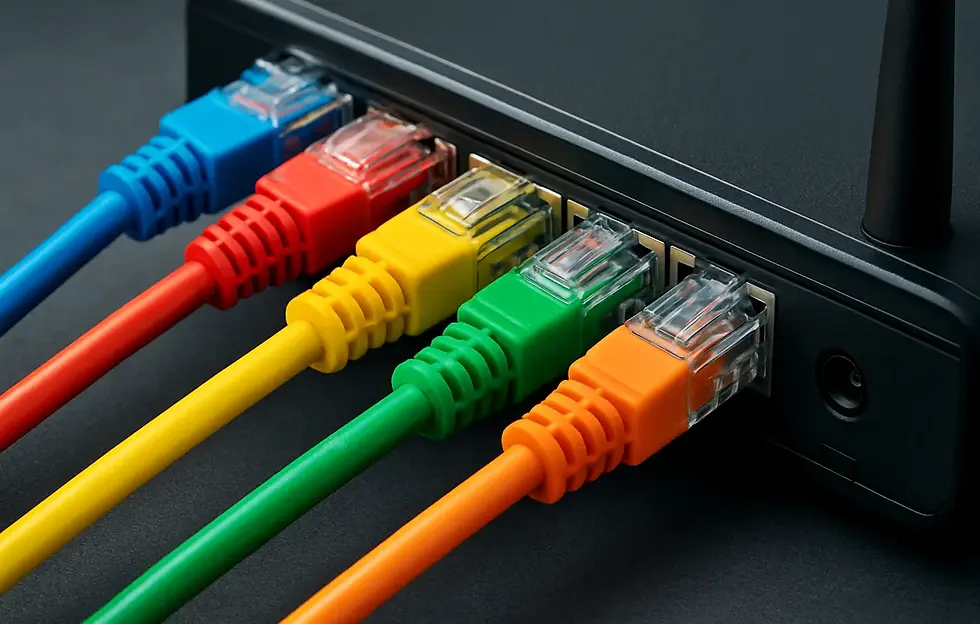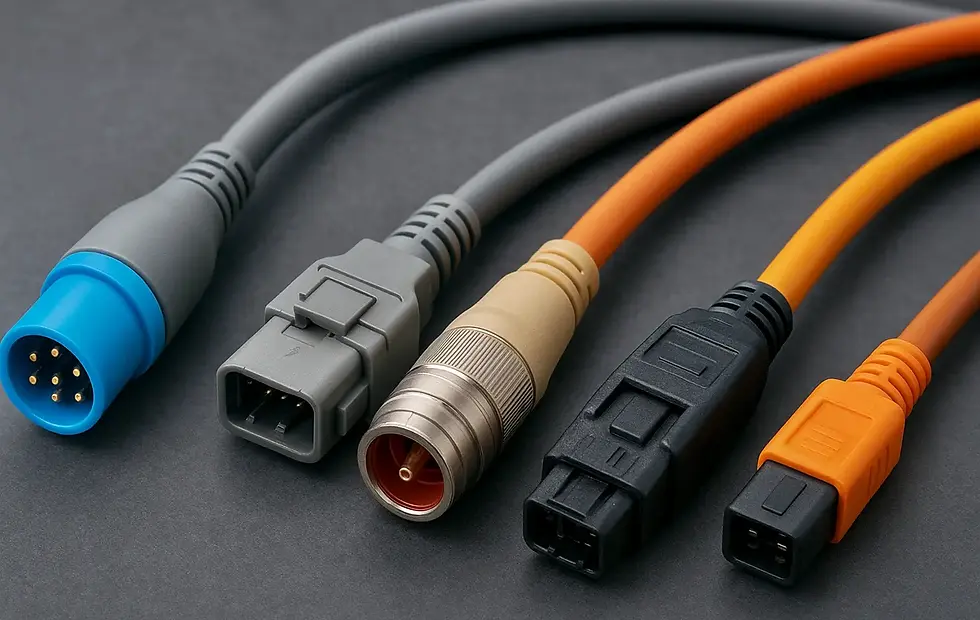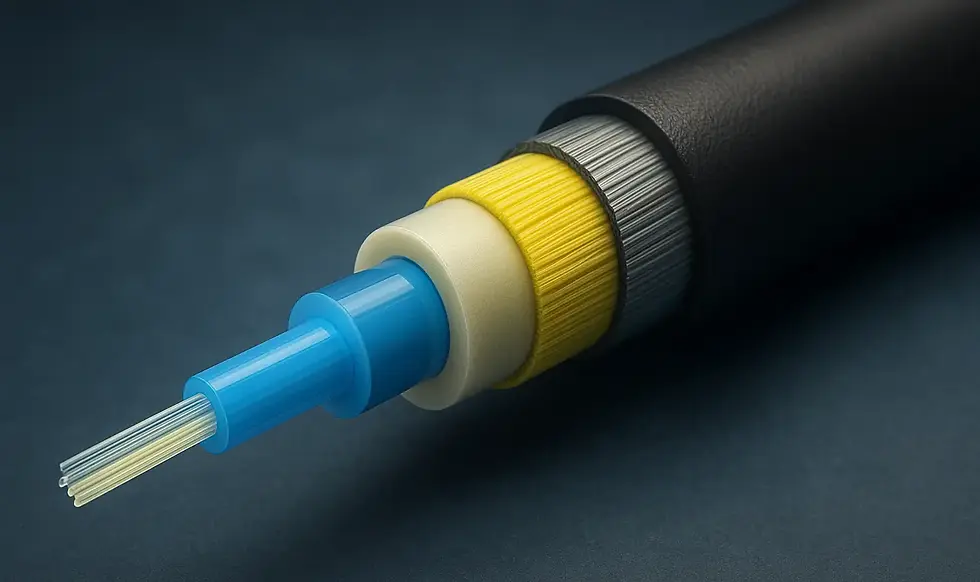Types of Cables: Complete Guide to Functions, Uses & Examples
- Kalyan Bhattacharjee

- Sep 17, 2025
- 5 min read
Updated: Nov 12, 2025

Let's Dive In | Cable Types & Functions
Cables are the backbone of modern communication, power, and data transfer. From charging your phone to powering industries, different types of cables serve specific purposes.
Knowing about these cables can help you pick the right one - whether for home use, office setups, or large-scale projects. In this guide, we’ll explore the main types of cables, their functions, and real-life applications.
Key Types of Cables and Where They’re Used
Cables come in many forms, built for tasks like powering devices, transmitting data, or carrying signals. Let’s explore the key types and their uses:
Power Cables 🔌
What it is: Power cables are designed to carry electrical energy from a source (like an outlet) to devices or appliances. In-short Power cables are designed to transmit electrical energy from one point to another.
Common Examples:
Low Voltage Cables: Used for household wiring and appliances.
High Voltage Cables: Found in industrial settings and power transmission lines.
Where it’s used:
Household appliances such as refrigerators, washing machines, and microwaves.
Computers, monitors, and power supply units (PSUs).
Industrial machinery requiring heavy-duty power cables.
Additional Note: They come in different types, like AC power cords for home use and DC power cables for devices like laptops and cameras. Some even include surge protection for safety. ✅
Ethernet Cables (Network Cables) 🌐
What it is: Ethernet cables provide a wired network connection for internet and local area networks (LANs).

Types of Ethernet Cables:
Cat5e: Basic, up to 1 Gbps speeds.
Cat6/Cat6a: Faster, ideal for gaming, streaming, and offices.
Cat7/Cat8: High-speed data transfer, mostly for data centers.
Where it’s used:
Home and office internet setups where stability and speed are crucial.
Gaming systems and streaming devices that require low latency.
Data centers and servers where high-speed networking is essential.
Additional Note: Variants like Cat5e, Cat6, and Cat7 offer progressively higher speeds and bandwidth, making Ethernet cables future-ready for increasing internet demands.
Audio Cables 🎧
What it is: Audio cables cables carry sound signals from one device to another. They come in analog (3.5mm jack, RCA) and digital (optical, AUX-to-USB) forms.
Types of Audio Cables:
Auxiliary (3.5mm jack): Phones, headphones, car audio.
RCA Cables: Used in older TVs and speakers.
XLR Cables: Found in professional microphones and audio setups.
Where it’s used:
Connecting headphones, microphones, and speakers.
Stereo systems, amplifiers, and sound mixers in studios.
Home theaters and car audio setups.
Additional Note: High-quality audio cables (like gold-plated jacks or optical cables) reduce noise and interference, providing clearer sound. ✅
Video Cables 📺
What it is: Video cables transmit video signals from one device to another. Older versions include VGA and DVI, while newer ones are HDMI and DisplayPort.
Types of Video Cables:
HDMI (High-Definition Multimedia Interface): The most common, used in TVs, monitors, and consoles.
VGA (Video Graphics Array): Old technology, still used for projectors.
DisplayPort: Popular in high-end monitors and gaming PCs.
Where it’s used:
Connecting monitors to computers and laptops.
Projectors and digital whiteboards in offices and schools.
Home theater and gaming setups.
Additional Note: Though HDMI has mostly replaced VGA and DVI, those older cables are still common in legacy systems. DisplayPort is often used in professional and high-end gaming monitors for higher refresh rates. ✅
USB Cables 🔋
What it is: USB (Universal Serial Bus) cables are everywhere for data transfer and charging. It is one of the most versatile cable type, used for data transfer, charging, and connectivity between countless devices.
Types of USB Cables:
USB-A to USB-B: Printers, scanners.
USB-C: Modern phones, laptops, and gadgets.
Micro-USB: Older Android devices, cameras, and accessories.
Where it’s used:
Charging smartphones, tablets, and wearables.
Data transfer between computers, external drives, and peripherals.
Connecting keyboards, mice, printers, and webcams.
Additional Note: The newer USB-C standard supports faster data transfer, higher charging speeds, and even video output, making it a single universal solution for many gadgets. ✅
Telephone Cables ☎️
What it is: Telephone cables carry voice signals and internet data over copper wires, traditionally in landline phones and DSL connections.
Types of Telephone Cables:
Coaxial Cable: Earlier telephone and cable TV connections.
Twisted Pair Cable (RJ11): Standard telephone lines.
Where it’s used:
Landline telephone networks in homes and offices.
DSL internet connections through RJ11 connectors.
Intercom and office PBX systems.
Additional Note: Although less common today due to mobile and fiber internet, telephone cables are still found in older systems and some rural areas. ✅
Fiber Optic Cables 💻
What it is: Fiber optic cables use light signals to transmit data at ultra-high speeds, making them the backbone of modern internet and communication.
Key Features:
Extremely fast data transfer
Immune to electromagnetic interference
Long-distance communication
Where it’s used:
High-speed broadband internet.
Data centers and enterprise networks.
Medical imaging equipment and military communications.
Additional Note: Unlike copper cables, fiber optics are immune to electromagnetic interference, allowing much faster and more reliable long-distance communication. ✅
Coaxial Cables 🏭
What it is: Coaxial cables are designed with a central conductor, insulation, and shielding to reduce interference during signal transmission.

Where it’s used:
Widely used in Cable television and satellite TV connections.
Broadband internet via cable modems.
CCTV systems for reliable video signal transmission.
Provides low signal loss over long distances.
Additional Note: Despite newer alternatives, coaxial cables remain in use because of their durability and ability to transmit signals over long distances with minimal loss. ✅
Ribbon Cables ⚡
What it is: Ribbon cables are flat, with multiple wires running parallel, resembling a ribbon. They are mainly used inside electronic devices.
Features:
Flexible, lightweight
Connects internal parts like hard drives, CD drives, and motherboards
Where it’s used:
Internal connections in computers (hard drives, CD/DVD drives).
Printers, fax machines, and scanners.
Industrial equipment and robotics.
Additional Note: They are compact, flexible, and allow multiple signal pathways in a small form, but are not meant for heavy power transmission. ✅
Specialized Cables 🧩
What it is: These are custom-made cables designed for specific industries and use cases.

Where it’s used:
HD-SDI Cable: Used in broadcasting and professional video.
Thunderbolt Cable: Ultra-fast data transfer and external displays.
Charging Cables (MagSafe, Proprietary): Device-specific charging solutions.
Medical cables for surgical equipment and patient monitoring.
Aerospace cables for aircraft systems where durability is crucial.
Additional Note: Specialized cables are often built with strict safety standards, shielding, and materials to withstand heat, moisture, or pressure, depending on the industry. ✅

Key Takeaways 🧠
Cables may seem simple, but they are vital to how we live and work. From power cables that keep your devices running to fiber optic cables that deliver ultra-fast internet, every type has a unique role.
When choosing a cable, always consider:
Purpose (Power, Data, Audio, Video)
Speed requirements
Compatibility with your device
The right cable not only makes your system efficient but also saves you time, money, and headaches.
Related Keywords: types of usb cables, types of charging cables, types of hdmi cables, types of cables, type of charge cable, what are the 3 types of cable, what type of ethernet cable do i need, are there different types of hdmi cables, are there different types of ethernet cables, what type of cable 4 dowyse webcam use, types of cables, types of wire, cable end types, types of electrical cables, types of computer cables, electric cables, specialized cables, coaxial cables, fintech shield




Comments